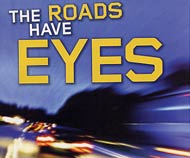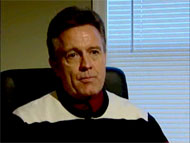11/5/2007
Opinion: The Roads Have Eyes, Part OnePart One of a two-part editorial by Richard Diamond detailing problems of fairness and accuracy that come with reliance upon photo enforcement.

View full article on a single page
Your days of being pulled over for speeding are numbered. That would be great news, except in an increasing number of states the flashing red and blue lights in your rear-view mirror are being replaced by the photographic flash of traffic cameras -- we'll call them automated ticketing machines, or ATMs. Sadly, these particular contraptions are the opposite of the familiar money-dispensing machines found outside our local banks. Instead, these devices take our money, and dispense it in massive bundles to voracious local governments.
The cameras come in two formats: red light cameras and speed cameras. Both types capture still photos or video clips of cars in motion -- cars that have somehow triggered, either rightly or wrongly, a virtual trip wire that says, in effect, "We just caught you breaking the law." The companies that operate the cameras on behalf of various jurisdictions later mail out the photos they've captured to the cars' registered owners, along with hefty fines for violating a state law or municipal ordinance. Speed cameras use radar, laser, or pavement-mounted sensors to create an estimate of speed. Red light cameras use a similar array of sensors to determine whether a car entered an intersection as little as a tenth of a second after the light has turned red.
If traffic cameras haven't yet come to your town, don't get too comfortable, because local governments are becoming increasingly interested in recruiting the obedient robot tax collectors. And collect they do. In Illinois, for example, roving vans park on the side of the road to facilitate the mailing of citations -- carrying fines of up to $1,000, plus insurance points -- to anyone driving a few miles-per-hour above the 45 MPH speed limit in a highway work zone. (And let's not even question the fairness of special "work zone" fines, except to point out that only about 15 percent of work zone fatalities are actually caused by automobile traffic.)
Following the lead of Illinois, Arizona will soon deploy permanently mounted speed cameras on freeways throughout the state. In just nine months last year, a pilot program in Scottsdale, AZ mailed out 120,000 speeding tickets with a face value of nearly $19 million. In other words, traffic cameras are serious business, generating more than a billion dollars every year for local governments and the insurance industry. While the cameras certainly cramp the styles of driving enthusiasts, a closer look at their implementation reveals that they also make our roads more dangerous and our legal system less fair.
False-Positives
When jurisdictions first decide to begin photo ticketing, officials uniformly swear by the uncanny accuracy and fairness of the traffic cameras. If you're doing nothing wrong, they say, you need not fear our machines. But if you think that anyone who doesn't speed on public roads or run red lights has nothing to fear, think again. Consider the case of Don Zimmerman, a Minneapolis, MN resident with a spotless driving record.
Stopped at a red light in August 2005, Zimmerman prepared to make a left-hand turn from a one-way street onto another one-way street. He inched his car slightly forward and allowed his front tires to cross the first line of the crosswalk. The light turned green, and Zimmerman slowly turned his Ford Focus around the corner. A series of flashes illuminated his rear-view mirror.
Six weeks later, Zimmerman opened his mailbox to find a $142 ticket for running the red light.
The ticket shocked Zimmerman, so he went online to check a video recording of the incident -- and saw that it proved nothing. So he took the next day off from work, paid $20 to store his car in a downtown garage (using a short-term metered spot would have guaranteed a parking ticket), and waited at city hall. Three-and-a-half hours later, a hearing officer looked at the video and agreed that Zimmerman was innocent. The officer then apologized because he actually had no authority to drop the fine. Zimmerman would have to go to court for that.
Exasperated, Zimmerman decided he wasn't about to pay another $20 and wait in line all over again. So instead of following instructions, he called a local television news reporter who threatened to televise Zimmerman's court hearing. The local police captain moved swiftly to dismiss the citation.
Zimmerman's story exposes one of the most significant problems arising from the use of machines to enforce traffic laws: Machines are incapable of fairness (let alone basic judgment), and they can't be cross-examined. This bothersome reality conflicts with the common-law principle of due process, and so our legal system must adapt to the concept of an unthinking device being the sole witnesses of a victimless crime. Most states -- with the exception of California, Arizona and Illinois -- side-step the issue by defining photo enforcement violations as "civil infractions" instead of "crimes." Civil infractions were institutionalized as a way to collect parking ticket revenue (now its own multi-billion dollar business) while eliminating the pesky, old-fashioned concept of "innocent until proven guilty."
The few states that maintain the criminal court system for photo tickets do so at a heavy cost: Overburdened courts get plagued with even more dockets (with taxpayers shouldering the bill), and drivers suffer higher insurance premiums for simply receiving camera citations -- the drivers' actual guilt or innocence notwithstanding.
Camera supporters like to trumpet the point that even if a camera does make a mistake, it's no big deal because the driver has the right to a fair hearing where the ticket can be challenged. That's due process enough, they say. After all, it's not like mistaken tickets are a regular occurrence.
Unless you're Don Zimmerman.
In December 2005, Zimmerman opened his mailbox and found another ticket for allegedly running a red light. Once again he checked the online video, which clearly revealed that it was the driver in an adjacent lane who tripped the sensor. Zimmerman bypassed his "fair hearing" and went straight to KARE television reporter Bernie Grace. In an interview with Grace, Minneapolis Police Captain Greg Reinhardt insisted that a police officer reviews every video to ensure only the guilty receive a ticket.
Zimmerman scoffed at the notion. "Either he has cataracts in his eyes," Zimmerman told us, "or he's reading the camera in Braille or something. There's no way anyone viewed that video."
The Minnesota camera enforcement program, like most of its type, takes advantage of those who don't want to go to the trouble and expense of issuing a challenge that can end up costing as much as the ticket itself. For all but a handful of drivers, it's much easier to write the check and be done with it.
Safety First?
Camera supporters argue that while their brainless sentries might make occasional mistakes, they're still worthwhile if they save just a single human life. With speed cameras, for example, the conventional wisdom is that drivers will see the cameras, and slow down to avoid being ticketed. Slower is safer, after all. With red light cameras, the assumption is that drivers fearing a ticket will decide not to gun it through an intersection, potentially T-boning a car headed the other way. Those who do receive tickets learn a valuable lesson, and share their cautionary tales with other drivers. There can be no better way of educating the public about safe driving.
Indeed, a number of studies funded by the Insurance Institute of Highway Safety (IIHS) claim fantastic reductions in the number of violations and accidents in areas where cameras are introduced. But these safety claims merit a closer look -- especially when you consider that the IIHS is wholly funded by the nation's top insurance firms, and the insurance industry makes billions from license points issued with traffic citations.
The first thing worth noting is that a high percentage of traffic camera tickets actually go to out-of-towners. A 2006 study of speed camera tickets issued Washington, D.C. indicated that about 80 percent of the citations went to non-District residents. (To date, the District has mailed out 2,952,333 photo fines -- the equivalent of five for each resident.) In Loma Linda, CA, 93 percent of the violations recorded last year were issued to drivers who were passing through the city. These numbers are relevant because negative-reinforcement therapy applied to out-of-towners does little to increase the safety consciousness of local residents.
This very issue was raised by Jim Bizieff, a police lieutenant in Union City, CA, which runs a red-light camera program. In an internal memo to his police chief, he discussed the experience of the neighboring city of Fremont, which had a camera program of its own. Bizieff wrote, "They believe that due to the huge volume of commuter traffic, that most violators are not local and the education/enforcement effort does not create a long-term reduction in violations for that reason." (View full memo in 260k PDF file)
Bizieff's memo documents another interesting fact: In Union City, the profit from each $361 red-light citation is split between the state, Union City, and Redflex, the Australian company that sets up the cameras, photographs drivers, mails the tickets, collects the cash, and, in many cases, offers the testimony in hearings. Redflex promised Union City that its system would generate about 1,897 photos each month. Sure enough, the first month's numbers were just about right on the money, with $547,560 worth of tickets mailed. (This dollar amounts represents about 1,500 tickets. The Union City cameras actually photographed more cars, but some photos were thrown out because they lacked clarity, or showed police cars or ambulances tripping the camera.)
Then something interesting happened. At one of the camera intersections (Union City Boulevard and Lowry Road), the number of citations plunged from 309 in September to 80 in December. Such a quick 58 percent drop in the number of violations would seem to indicate that the cameras were working as promised. Or was something else going on?
"The initial projections, as well as the first few weeks of operation, were based on faulty yellow light timings," Bizieff's memo explains. "October 2005 was the first full month with the system operating with the correct yellow light timings. There is an obvious drop-off in incidents and citations from August to October."
To put Bizieff's memo in perspective, it's important to know that the duration of a yellow light has a profound effect on safety. Imagine what would happen if you were approaching an intersection, and the light flashed yellow for just a half-second before changing to red. If you were far enough back when the yellow flashed, you would have no problem stopping. But picture yourself closer to the crosswalk when the light flashes yellow. You're now faced with a split-second decision -- either run the red light or slam on the brakes and risk a rear-end collision.
Engineers use the term "dilemma zone" to describe the moment of confusion created by inadequate yellow warning times. Stuck in the dilemma zone, many motorists choose to run the imminent red light as the lesser of two evils.
Given the obvious importance of proper yellow light timing, you might assume Union City fixed its timing problem willingly. You'd be wrong. Dave Goodson, a motorist with an engineering background, performed a number of measurements and calculations after receiving a ticket at Union City Boulevard and Lowry Road. His case forced Union City's traffic engineers to concede that they had set the yellow signal time 1.3 seconds too short. The timings weren't faulty, they were illegal.
They were also profitable.
Read Part Two of this opinion piece. First published in the Summer 2007 edition of High Performance Driving magazine.



